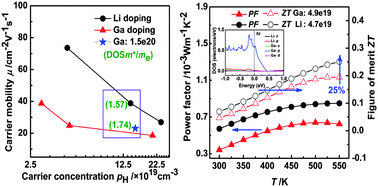Low effective mass and carrier concentration optimization for high performance p-type Mg2(1−x)Li2xSi0.3Sn0.7 solid solutions
Abstract
Mg2Si1−xSnx solid solutions are promising thermoelectric materials for power generation applications in the 500–800 K range. Outstanding n-type forms of these solid solutions have been developed in the past few years with the thermoelectric figure of merit ZT as high as 1.4. Unfortunately, no comparable performance has been achieved so far with p-type forms of the structure. In this work, we use Li doping on Mg sites in an attempt to enhance and control the concentration of hole carriers. We show that Li as well as Ga is a far more effective p-type dopant in comparison to Na or K. With the increasing content of Li, the electrical conductivity rises rapidly on account of a significantly enhanced density of holes. While the Seebeck coefficient decreases concomitantly, the power factor retains robust values supported by a rather high mobility of holes. Theoretical calculations indicate that Mg2Si0.3Sn0.7 intrinsically possesses the almost convergent double valence band structure (the light and heavy band), and Li doping retains a low density of states (DOS) on the top of the valence band, contrary to the Ga doping at the sites of Si/Sn. Low temperature specific heat capacity studies attest to a low DOS effective mass in Li-doped samples and consequently their larger hole mobility. The overall effect is a large power factor of Li-doped solid solutions. Although the thermal conductivity increases as more Li is incorporated in the structure, the enhanced carrier density effectively shifts the onset of intrinsic excitations (bipolar effect) to higher temperatures, and the beneficial role of phonon Umklapp processes as the primary limiting factor to the lattice thermal conductivity is thus extended. The final outcome is the figure of merit ZT ∼ 0.5 at 750 K for x = 0.07. This represents a 30% improvement in the figure of merit of p-type Mg2Si1−xSnx solid solutions over the literature values. Hence, designing low DOS near Fermi level EF for given carrier pockets can serve as an effective approach to optimize the PF and thus ZT value.



 Please wait while we load your content...
Please wait while we load your content...